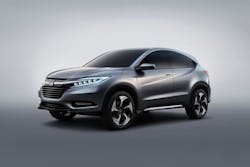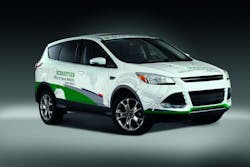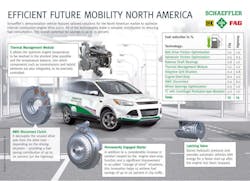Cities offer notoriously difficult driving environments, ones that favor compact and subcompact cars in as their small stature and maneuverability nicely deal with tight spaces and roadways choked with traffic, all while delivering superb fuel economy. Yet the drawback of the compact and subcompact vehicle genre is obvious: they can get you from here to there, but not much else.
That then is the conundrum several new concept vehicles displayed at the 2013 North American International Auto Show (NAIAS) in Detroit are trying to solve.Take for example the "Urban SUV Concept" vehicle developed by Japanese automaker Honda, which is the starting point for a new small sport utility vehicle (SUV) model the OEM plans to launch in Japan by the end of 2013, followed by the U.S. market in 2014.
John Mendel, executive VP-sales for Honda’s American division, said the Urban SUV Concept is intended to provide the basis for a fun-to-drive and fuel-efficient small SUV combined with what he called an “aspirational” design, flexible packaging and “next-generation” connectivity.
Here’s the interesting part, though: the vehicle measures just 169.3 inches long, some nine inches shorter than the Honda CR-V, making the Urban SUV Concept the “ideal size” for navigating both crowded city streets as well as open mountain roads, Mendel said.
More importantly, it’s configured in such a way to maximize interior space – a critical attribute for vehicles aimed at operating in crowded urban centers.
To get that space, Honda built this concept vehicle around a center fuel-tank layout used by its subcompact “Fit” sedan, along with what the OEM calls a configurable “Magic Seat” setup to provide a host of passenger and cargo options, including a fold-flat mode for maximum cargo capacity.
Another automotive supplier at NAIAS – German drivetrain maker Schaeffler AG – presented a new concept vehicle as well, dubbed the “Efficient Future Mobility North America” vehicle and based on a mid-size SUV platform as way to “optimize” internal combustion engine drivetrains.Peter Gutzmer, chief technology officer for Schaeffler AG, said this “mobility” mid-size SUV concept serves as a “demonstration vehicle” for the components and systems that are bundled within it. “Even with the efficient platform we selected, we still see further potential for optimization,” he explained, noting that when they are integrated into an all-wheel drive (AWD) vehicle can potentially provide up to 15% in fuel efficiency.
Gutzmer said this concept vehicle is based on the current version of a mid-size SUV that is popular in North America and features an automatic transmission with a torque converter. A wide range of technologies are deployed in this vehicle to help boost fuel economy, from a thermal management module and AWD separating clutch to engine “start-stop” systems and a permanently engaged starter with a wrap spring one-way clutch.
He added that vehicle’s fuel savings also result from “friction optimization” work being carried out on belt drives and valve trains, as well as advancements to balancer shafts and wheel bearings – a mechanism for aerodynamically optimized closing of radiator grills – and the optimization of the torque converter.The new AWD separating clutch, which decouples the unused drive axle from the drive train depending on the driving situation, can potentially offer fuel savings of up to 6% on the highway, with a 2% savings in city traffic, though the permanently engaged starter generator with a wrap spring one-way clutch can offer additional city driving improvements, Gutzmer pointed out.
In addition to a considerable increase in comfort, due to the smooth engine start-stop function, and a significant improvement in so-called "change of mind" situations – in which the engine is already switched off, but the driver quickly decides to drive on – the “start-stop” function can save a further 6% in city traffic.
Engine “start-stop” can also deliver fuel savings on the highway, as it provides additional functions such as "sailing" where the drive train decouples and the internal combustion engine switches off as the vehicle is moving at high speed, he noted.
Another 1% reduction in fuel consumption can be achieved through the integration of a thermal management module, which helps the engine achieve optimum operating temperature in the shortest time possible and also aligns said temperatures with hybrid propulsion systems.
Jeff Hemphill, chief technology officer for Schaeffler’s North American subsidiary added that this “mobility” SUV project is structured in two phases, with the objective of phase one to fulfill the corporate average fuel economy (CAFÉ) rules being put in place for light vehicles in 2020.
“In the second phase, we will add hybrid systems with the aim of fulfilling the requirements for the year 2025,” he said.
It’ll be a great thing such concept vehicles ultimately deliver more capability and improved fuel efficiency in the same package.



